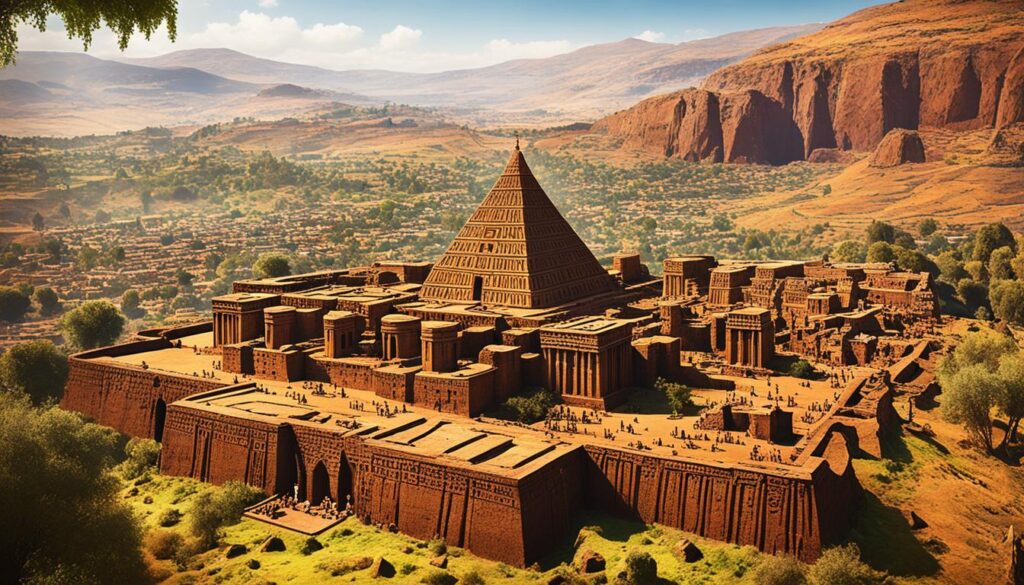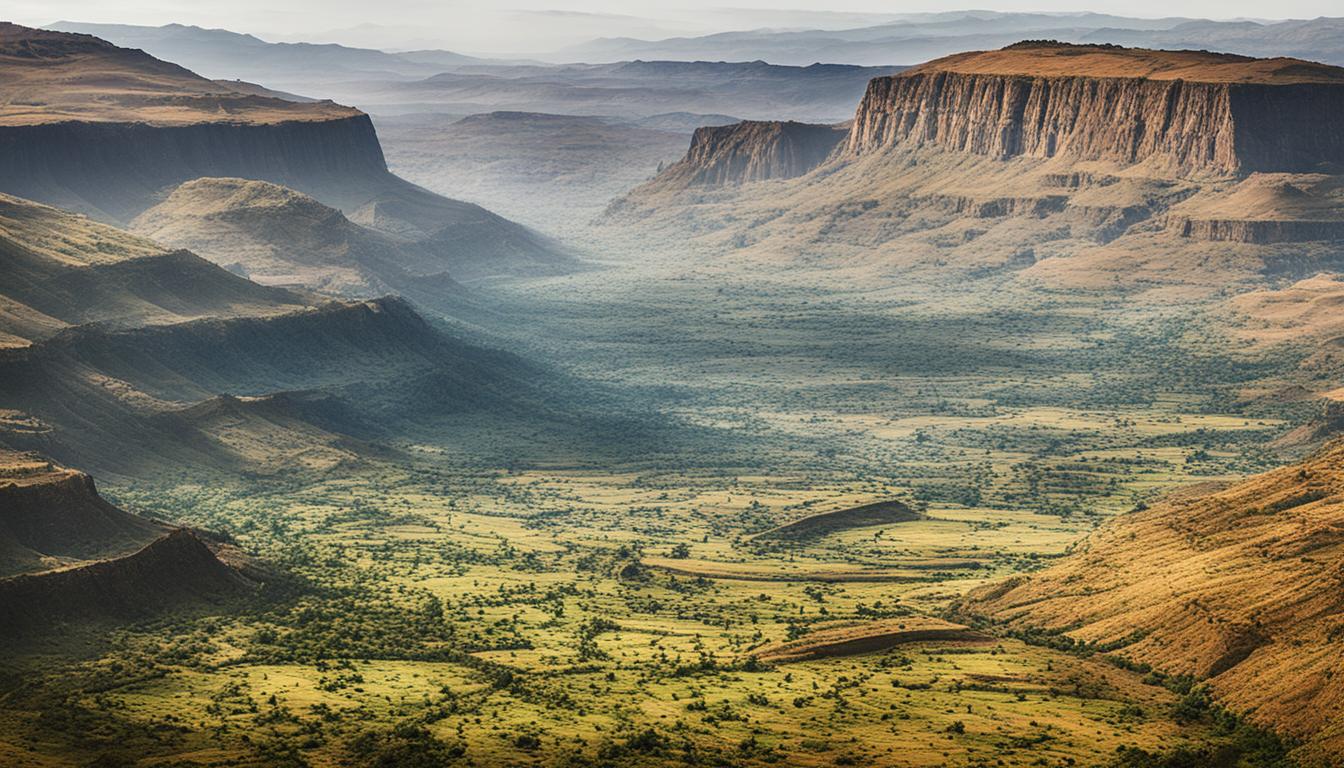How Big Is Ethiopia?
Did you know that Ethiopia covers a land area of 1,112,000 square kilometers (429,000 square miles), which is roughly the same size as France and Spain combined? This surprising fact highlights the immense geographical expanse of Ethiopia, making it one of the largest countries in Africa. Let’s delve into the details and explore the geographical features, cultural diversity, and historical significance of this captivating nation.
Key Takeaways:
- Ethiopia is similar in size to France and Spain combined.
- It covers a land area of 1,112,000 square kilometers (429,000 square miles).
- With a population of around 128 million people, Ethiopia is the 2nd most populous country in Africa.
- Ethiopia shares borders with Eritrea, Djibouti, Somalia, Kenya, South Sudan, and Sudan.
The Geographical Features of Ethiopia
Ethiopia, located in the Horn of Africa region, boasts a diverse range of geographical features that captivate travelers from around the world. From majestic highlands to stunning lakes and rivers, the country’s natural beauty is truly awe-inspiring.
The Abyssinian Highlands: A Land of Peaks
One of Ethiopia’s most prominent geographical features is the Abyssinian Highlands, which stretch from the northern to the central part of the country. This mountainous region is home to more than 25 mountains with peaks soaring over 4,000 meters (13,200 feet) above sea level. These majestic mountains, such as Mount Ras Dashen and Mount Bwahit, offer breathtaking views and challenging trekking opportunities for adventure enthusiasts.
The Central Plateau: A Tapestry of Varying Heights
Spanning across the heart of Ethiopia, the central plateau showcases a diverse range of elevations. The plateau varies in height between 2,000 and 3,000 meters (6,500 and 9,800 feet) above sea level. This rugged terrain not only provides a stunning backdrop to the country but also contributes to its varied climate and unique ecosystems.
The Rift Valley Lakes: A Water Oasis
Sprinkled throughout the Ethiopian landscape are the breathtaking Rift Valley Lakes. These scenic lakes, including Lake Abijatta, Lake Langano, and Lake Chamo, offer a tranquil escape and an abundance of wildlife. Whether you’re a birdwatching enthusiast or simply seek a peaceful retreat, these picturesque lakes provide ample opportunities for relaxation and exploration.
The Blue Nile: A Lifeline of Ethiopia
Flowing through the heart of Ethiopia is the legendary Blue Nile. Originating from Lake Tana, this mighty river traverses a distance of 1,450 kilometers (900 miles) and converges with the White Nile in Khartoum. The Blue Nile not only serves as a vital source of water and fertile soil for agriculture but also contributes to the breathtaking landscapes that define Ethiopia.
To truly appreciate the geographical wonders of Ethiopia, it is essential to embark on an unforgettable journey through its diverse terrains, where you can witness the harmonious interplay between nature and culture.
“Ethiopia’s geographical diversity never ceases to amaze me. From the towering peaks of the Abyssinian Highlands to the tranquil beauty of the Rift Valley Lakes, every corner of this country offers a unique and captivating experience.” – Traveler💗
| Geographical Feature | Description |
|---|---|
| Abyssinian Highlands | A mountainous region with more than 25 peaks rising over 4,000 meters (13,200 feet). |
| Central Plateau | A varied landscape with elevations ranging between 2,000 and 3,000 meters (6,500 and 9,800 feet). |
| Rift Valley Lakes | A collection of scenic lakes offering tranquility and rich biodiversity. |
| Blue Nile | A mighty river flowing through Ethiopia, shaping its landscapes and providing essential resources. |
Exploring Ethiopia’s geographical wonders is an adventure that will leave a lasting impression. The vastness of its land mass, the dimensions of its highlands, and the square footage of its lakes and valleys all contribute to Ethiopia’s unmatched beauty and allure.
Ethiopia’s Cultural Diversity and Ethnic Composition

Ethiopia is a country known for its rich cultural tapestry and diverse ethnic composition. With over 80 different ethnic groups, Ethiopia is a multi-ethnic state that showcases a vibrant mix of traditions, languages, and customs. Let’s explore the fascinating ethnic landscape of Ethiopia.
The Oromo and Amhara Ethnic Groups
Among the numerous ethnic groups in Ethiopia, the Oromo and Amhara are the most populous and influential. These two groups together constitute approximately 60% of the total population of Ethiopia.
“The Oromo and Amhara ethnic groups form the majority in Ethiopia, shaping the country’s cultural and social fabric.”
Diverse Religious Beliefs
Religion plays a significant role in Ethiopian society. Christianity is the most widely professed faith, with around 67% of Ethiopians identifying as Christians. The Ethiopian Orthodox Church, which has its own unique practices and traditions, is one of the oldest Christian churches in the world.
Islam is the second-largest religion in Ethiopia, with a considerable Muslim population. Other minority religions and traditional faiths are also practiced by smaller segments of the population.
Rural Population Dominance
Ethiopia’s population is predominantly rural, with approximately 85% of people living in rural areas. This reflects the country’s agrarian economy and the importance of agriculture in the daily lives of Ethiopians.
While Ethiopia’s urban centers are growing rapidly, the majority of the population still resides in rural communities, maintaining strong ties to their ancestral lands and traditional ways of life.
Take a look at the ethnic diversity and population distribution in Ethiopia:
| Ethnic Group | Population Percentage |
|---|---|
| Oromo | 34.5% |
| Amhara | 27% |
| Somali | 6.2% |
| Tigray | 6.1% |
| Sidama | 4% |
| Afar | 2.7% |
| Gurage | 2.5% |
| Somali | 4.7% |
| Others | 12.3% |
As you can see, Ethiopia’s ethnic groups contribute to the country’s diverse and vibrant cultural landscape. The rich tapestry of traditions, languages, and customs offers a unique experience for those eager to immerse themselves in Ethiopia’s cultural heritage.
Historical Significance of Ethiopia

Ethiopia holds a remarkable place in history, with a rich and diverse past that spans over 3,000 years. This ancient land is believed to be the birthplace of anatomically modern humans, with significant archaeological discoveries made in the Awash Valley.
“Ethiopia is where it all began, the cradle of humanity.”
One of the most influential periods in Ethiopian history was the reign of the Kingdom of Aksum, which lasted from 400 BC to the 10th century AD. Aksum was known for its advanced civilization and played a prominent role in the region.
The Kingdom of Aksum’s historical significance is also intertwined with the spread of Christianity. In 330 AD, it became the first state to adopt Christianity as its official religion, making Ethiopia one of the oldest Christian nations in the world.
Throughout its history, Ethiopia has demonstrated resilience against colonial powers. A notable event took place in 1896 when Ethiopia’s forces successfully defeated the Italian army in the Battle of Adwa, securing their independence and inspiring other African nations in their fight against colonization.
| Significant Periods | Events |
|---|---|
| Ancient Ethiopia | Archaeological discoveries in the Awash Valley suggest the birthplace of anatomically modern humans |
| Kingdom of Aksum | Advanced civilization, adoption of Christianity in 330 AD |
| Battle of Adwa | Victory over Italy in 1896, defending Ethiopian independence |
Ethiopia’s historical significance is a testament to the country’s enduring spirit and the influential role it has played in shaping the region and the world.
Conclusion
In conclusion, Ethiopia offers a truly remarkable experience for those seeking adventure, cultural immersion, and a glimpse into its rich history. With its vast geographical size, including breathtaking landscapes like the highlands and Rift Valley Lakes, Ethiopia captivates visitors with its natural beauty. But it’s not just the scenery that is awe-inspiring; Ethiopia’s cultural tapestry is equally captivating, with over 80 different ethnic groups contributing to the diverse mosaic of traditions, languages, and customs.
Exploring Ethiopia means delving into a country that has preserved its ancient history and achieved significant milestones. From being the birthplace of anatomically modern humans to witnessing the rise and fall of the Kingdom of Aksum, Ethiopia’s historical significance is undeniable. The country’s resistance to colonial powers, like Italy, highlights its strong spirit and determination, exemplified by the historic Battle of Adwa.
For travelers, Ethiopia is a treasure trove waiting to be discovered. Immerse yourself in the mesmerizing landscapes, interact with friendly locals, savor the flavors of Ethiopian cuisine, and learn about the country’s captivating history. Whether you’re hiking through the majestic mountains, exploring the vibrant markets, or visiting ancient rock-hewn churches, Ethiopia offers an experience like no other.



